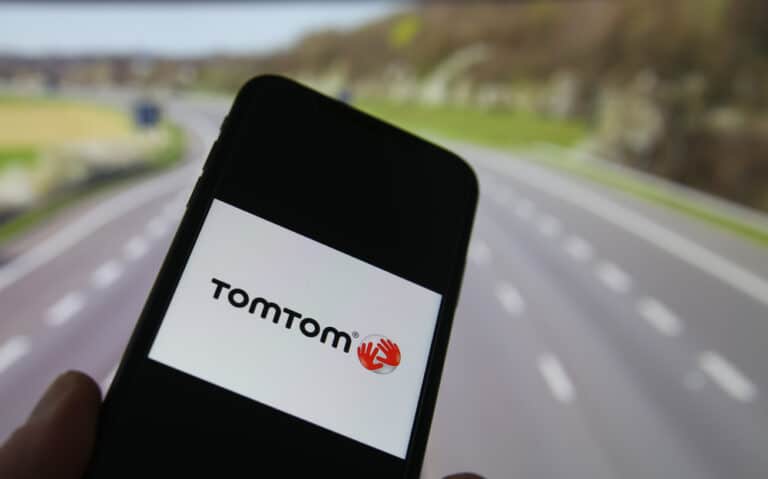Generative AI will soon descend on the car. TomTom and Microsoft are joining forces to provide drivers with an in-car AI assistant. It promises to offer more than just a gimmick, provided car makers play along.
TomTom has built a “conversational automotive assistant” using Microsoft’s AI suite. This assistant aims to make voice control in the car a lot more natural than before. This should offer considerably more advanced functionality than the current voice commands within Android Auto and Apple CarPlay, which are in essence integrations of Google Assistant and Siri, respectively, into the infotainment system. In those solutions, one’s voice acts only as an alternative to button or touch controls.
TomTom’s new innovation should make it possible to change everything from heating controls to navigation and radio stations. That in itself may not sound too revolutionary. Yet the new approach has the potential to offer much more than just Siri 2.0. It owes that to its integration with Microsoft’s AI services.
Not ChatGPT in the car
TomTom’s implementation hooks into the Microsoft Azure OpenAI Service, which features a wide suite of LLMs and additional services, such as text-to-speech via Azure AI Speech. This has the flexibility built-in to allow automakers to make all kinds of adjustments, allowing proprietary applications and services to fully integrate with the onboard AI assistance. Such data can be deployed via Azure Cosmos DB and the “built-in responsible AI” should ensure that undesirable outputs are prevented. Microsoft itself has already claimed that strong results can be obtained from an AI model with a high-quality dataset, even with the “small language model” Phi-2.
In other words, the announcement is a push to make it easier for car makers to implement generative AI. Although TomTom is providing a showcase at CES 2024, it will be some time before a car with the new AI assistant is out in the wild. Still, with this integration with Microsoft, it can benefit from the innovations that the Redmond tech giant and OpenAI are implementing on Azure, with new models, better fine-tuning and stronger guardrails to make AI outputs reliable.
An announcement about generative AI ending up in your isn’t new. For example, Mercedes-Benz tested an integration with ChatGPT into its own MBUX system in the middle of this year. 900,000 drivers participated in this beta test, without further results being shared. Either way, there were mostly some musings from Mercedes about an eventual AI future, with no concrete integrations to boast about. While we may not have a firm launch date from TomTom, this time, it doesn’t seem to be an announcement just capitalizing on hype.
What will be possible
The Amsterdam-based company offers the TomTom Digital Cockpit, in which the new AI solution can also be found. The emphasis here is on an open and modular structure. This ensures that car manufacturers can decide for themselves what they do and do not want to adopt from this offering.
On other fronts, Microsoft and TomTom are already familiar bedfellows. For example, both parties are prominent members of the Overture Maps Foundation. In time, the foundation hopes to offer an open-sourced digital twin of the entire globe. In doing so, it will supplement TomTom’s existing expertise in navigation maps with data from other parties. This will allow an AI assistant to have even more information, if such data finds its way into the Azure OpenAI Service.
Microsoft itself has already been running the Connected Vehicle Platform (CHV) for years, which TomTom contributed to in 2019 with its navigation technology. Things are relatively quiet around this platform, it has to be said. This is somewhat odd, given that Microsoft is still working on various innovations for automotive (but it does not mention CHV in the process). Such initiatives quickly jump to an eventual future of self-driving cars, a pattern that’s evidently shared by car makers. In fact, the concept of the “connected car” is much broader than that objective and offers more direct benefits in a more short-term timeframe. For example, the announcement of the new AI assistant also talks about cloud analytics, which TomTom says will complement the “in-vehicle digital cockpit” and the infotainment system. Specifically, this could involve predictive analytics, keeping an eye on when a car needs maintenance and how to instruct users to drive as efficiently as possible, for example, by indicating this visually on the dashboard. If such things are also integrated into an AI assistant, we can eventually, tentatively, call it a real two-way conversation between driver and chatbot. For the time being, however, it is being presented as what’s essentially Siri 2.0. The long-term goal will be a lot more ambitious, as otherwise it’s a lot of work to put in for a minor advancement.
Also read: Open mapping is the future, according to Overture Maps
